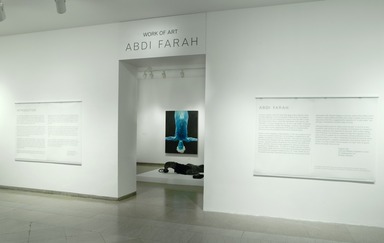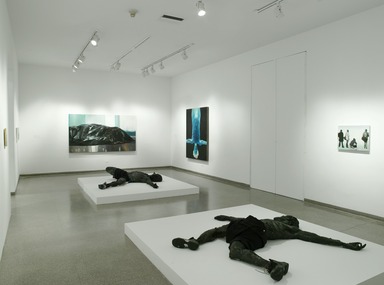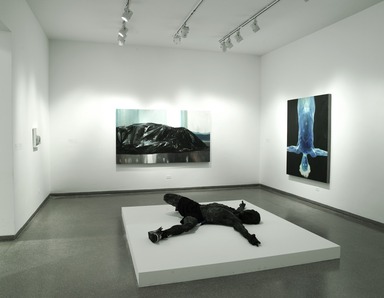

Work of Art: Abdi Farah, August 14, 2010 through October 17, 2010 (Image: DIG_E2010_Abdi_Farah_01_PS4.jpg Brooklyn Museum photograph, 2010)

Work of Art: Abdi Farah, August 14, 2010 through October 17, 2010 (Image: DIG_E2010_Abdi_Farah_02_PS4.jpg Brooklyn Museum photograph, 2010)

Work of Art: Abdi Farah, August 14, 2010 through October 17, 2010 (Image: DIG_E2010_Abdi_Farah_03_PS4.jpg Brooklyn Museum photograph, 2010)
Work of Art: Abdi Farah
DATES August 14, 2010 through October 17, 2010
ORGANIZING DEPARTMENT
Special Exhibition
COLLECTIONS
Contemporary Art
-
ABDI FARAH
Luminous Bodies is the title Abdi Farah gave to this exhibition when it initially appeared on the final episode of Work of Art. According to the artist, the title was inspired by a scene in the Star Wars movie The Empire Strikes Back in which the Jedi Master Yoda says to Luke Skywalker, “Luminous beings are we, not this crude matter.” Produced over a period of three months, the paintings, sculpture, and drawings on view reflect Farah’s explorations of the body as a material entity that possesses the potential to transcend its physical being.
Libation is the centerpiece of the exhibition. A life-size sculpture of two young men sprawled on the floor, its immediacy is heightened by the addition of sneakers on the feet of both men. The drawing Ichabod and the painting Grey (Farewell Line) also represent the figure in a naturalistic manner, capturing poses and gestures from behind. Poor Reflection, Mirror, and Alien show the body disjointed by radical cropping and rendered in irradiated colors. The title of a related painting, Tuskegee (Warm Body), makes reference to the infamous biomedical experiments conducted at the Tuskegee Institute by the U.S. Public Health Service. The electric hues that characterize these last four works reveal Farah’s fascination with infrared imaging, commonly used by the military and in medicine, while Untitled and Home each show a partial view of a body bag lying on the floor, suggesting the expiration of “crude matter” and, perhaps, a threshold to another state of being.
Although Farah posed for these works himself, in front of a low-resolution Web camera on his computer, he took pains to conceal his identity, hoping to reach beyond the personal. After further editing with Photoshop, the resulting images provided the inspiration for his work, which he regards as a commentary drawing attention to the disenfranchised in our culture. Defamiliarizing what we know by using unusual viewpoints, cropped compositions, and vibrant colors, he invites us to take another look at people we might wish to ignore, and to reconsider what we see.
Eugenie Tsai
John and Barbara Vogelstein Curator of Contemporary Art
Brooklyn Museum -
Introduction
This presentation spotlights the winner of Work of Art, a recently concluded, creative competition among contemporary artists from across the United States for a cash prize and this exhibition at the Brooklyn Museum. The competition aired as a Bravo cable television series—a “reality TV” show, much like others that have pitted aspiring chefs or fashion designers against each other.
Though it may seem an unconventional presentation, contests such as Work of Art are not unfamiliar to art museums. In nineteenth-century France, the principal route to prominence for an artist was to enter his or (rarely) her work in a competition held every year or two at the Louvre. A jury of experts presided, selecting from thousands of submissions. The works chosen were presented in huge exhibitions that were extremely popular with the public.
That tradition of the competitive “juried exhibition,” greatly modified for a different age and culture, crossed the Atlantic and became a staple of American museums through much of the twentieth century. Indeed, though the juried show has fallen out of favor at some museums that have full-time contemporary-art specialists on staff, it is still common for many institutions to hold competitive exhibitions judged by panels of outside art experts.
Work of Art is a direct descendent of the juried-exhibition tradition. The judges included art collector and series host China Chow; New York magazine critic Jerry Saltz; and gallerists Jeanne Greenberg Rohatyn and Bill Powers. Art auctioneer Simon de Pury participated as mentor to the contestants, and a different guest judge joined the panel each week. The Brooklyn Museum’s John and Barbara Vogelstein Curator of Contemporary Art, Eugenie Tsai, advised in the final selection of the winner.
If the Brooklyn Museum’s participation in Work of Art is analogous to a juried show, it is also an experiment in serving the Museum’s audience in new ways. The world changes constantly, and art changes with it, as do the ways audiences engage with art. Reality television—in this case, the on-camera interactions between artists, critics, and dealers—offers a dynamic new way for viewers to encounter works of art.
Yet at the same time, the actual, physical objects themselves, now gathered in this gallery, make a direct, unmediated appeal to the viewer’s eye. Here, you can experience them first-hand, in the flesh, so to speak, and discover what they have to say to us. This is the reality that museums offer to the public.
Charles Desmarais
Deputy Director for Art
Brooklyn Museum
-
August 1, 2010
Work of Art: Abdi Farah, an exhibition of work by the winner of Work of Art, Bravo’s hour-long creative competition 10-part television series among contemporary artists, will open to the public on Saturday, August 14. This exhibition, which will be on view at the Brooklyn Museum through October 17, 2010, highlights ten artworks recently created by Abdi Farah in a variety of media.
Libation, a life-size sculpture of two young men sprawled on the floor, is the centerpiece of the exhibition. Its immediacy is heightened by the addition of sneakers on the feet of both men. The drawing Ichabod and the painting Grey (Farewell Line) also represent the figure in a naturalistic manner, capturing poses and gestures from behind.
Poor Reflection, Mirror, and Alien show the body disjointed by radical cropping and rendered in irradiated colors. The title of a related painting, Tuskegee (Warm Body), refers to infamous biomedical experiments conducted at the Tuskegee Institute by the U.S. Public Health Service. The electric hues that characterize these last four works reveal Farah’s fascination with infrared imaging, commonly used by the military and in medicine. Untitled and Home each show a partial view of a body bag lying on the floor, suggesting perhaps a transition to another state of being.
Produced over a period of three months, the figurative paintings, sculpture, and drawings on view reflect Farah’s investigation of the human body as a material entity with the potential to transcend its physical being. A recent graduate of the University of Pennsylvania, Farah participated in the Yale Norfolk Summer School of Art in 2008. He was also named a Presidential Scholar in the Arts and was awarded the Scholastics Art and Writing Gold Portfolio.
Work of Art: The Next Great Artist is a recently concluded creative competition show among contemporary artists from across the United States for a cash prize and this exhibition at the Brooklyn Museum. The competition aired as a Bravo cable television series—similar to other shows on the network that have pitted aspiring chefs or fashion designers against one other. Contests such as Work of Art are not unfamiliar to art museums. In nineteenth-century France, the principal route to prominence for an artist was to enter a competition held every year or two at the Louvre. A jury of experts presided, selecting from thousands of submissions. That tradition of the competitive “juried exhibition,” greatly modified for a different age and culture, crossed the Atlantic and became a staple of American museums through much of the twentieth century.
Work of Art is a direct descendent of the juried-exhibition tradition. The judges included art enthusiast and series host China Chow, New York magazine art critic Jerry Saltz, and gallerists Jeanne Greenberg Rohatyn and Bill Powers. Art auctioneer Simon de Pury participated as mentor to the contestants, and a different guest judge joined the panel each week. The Brooklyn Museum’s John and Barbara Vogelstein Curator of Contemporary Art, Eugenie Tsai, advised in the final selection of the winner.
The exhibition Work of Art: Abdi Farah has been organized by the Brooklyn Museum in cooperation with Bravo, as well as the show’s production companies, Magical Elves and Pretty Matches. Eugenie Tsai, John and Barbara Vogelstein Curator of Contemporary Art at the Brooklyn Museum, is curator of the exhibition.
Press Area of Website
View Original

